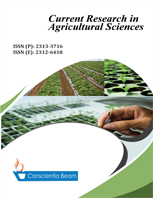The Extent of Finger Millet Production in South Omo Zone in the Case of South Ari Woreda
DOI:
https://doi.org/10.18488/journal.68/2015.2.1/68.1.1.7Abstract
In Ethiopia finger millet occupies 4% of the total area allocated to cereals (nearly half a million hectares) each year and also contributes about 4% to the total annual cereal grain production in the country. The production area increased from 342,120 ha to 368,999 ha with an increase of 7.3%, and the productivity increased from 3,769,290 to 5,241,911 quintals with a proportion of 28%. Six varieties (Tadesse, Padet, Wama, Baruda, Degu and Boneya) have been identified for cultivation to date. Though the varieties were initially released for cultivation in the sub-humid and mid altitude areas, their inadvertent introduction in to low rainfall areas found new adaptation zones. The production of these varieties has expanded to dry low altitude areas including regions where the crop was previously unknown. As a result of frequent drought, farmers in the dry rift valley region of Ethiopia widely adopted the variety that it is currently grown as one of the most important crops in this region. Therefore this study was initiated to discuss the production of finger millet in South Omo Zone, Ari woreda and generates information on the extent of finger millet production which is useful in designing suitable approaches for identifying gaps and intervening production constrains in the target area.The study areas comprised major finger millet producing kebeles of Ari woreda. Ten kebeles were selected systematically. Six year data on finger millet production and productivity was taken from woreda and each kebele. Data were collected through key informant interviews, focus group discussions, and questionnaires during a three-month period .Research in south omo zone, southern research institute and several national programs have resulted in considerable progress and identification of some improved finger millet varieties. The production of the crop in the study area is increasing.

